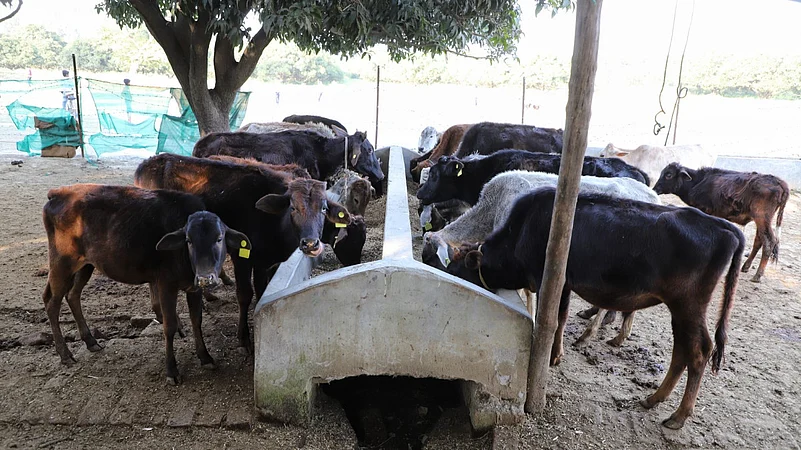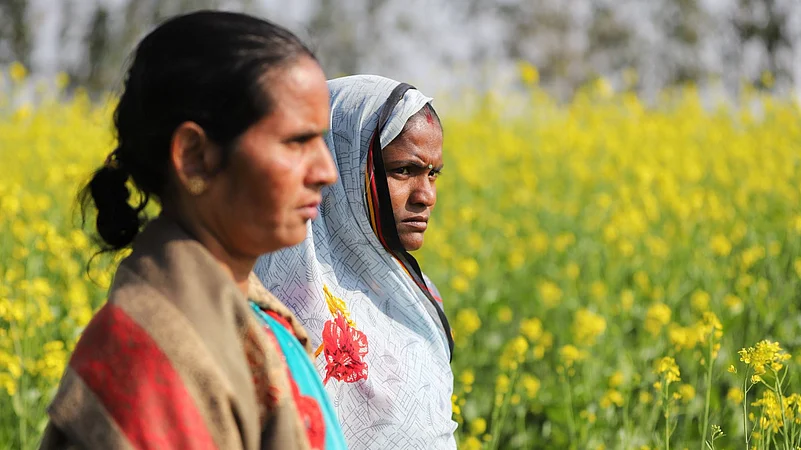On the morning of 31 January, Suresh Maurya’s father Jagdev Prasad went out for his usual walk in the tomato patch. He would check on the plants, and spend hours among the lush, red orbs, his favourite crops. “That’s when he spotted him,” Suresh says. A stray bull who had entered the nearby farm to graze had spotted Binu and decided to give chase. When Jagdev saw the charging animal run at him, he tried to escape but couldn’t outspeed the charging bull who dug his horns right through Jagdevs skint pelvis.
Jagdev is one of three persons that locals claim died after being attacked by stray cattle in the nearby villages of Arthapur, Sultanpur and Dadhnamau villages in Uttar Pradesh’s Sitapur district in the last year. The problem of stray cattle has become endemic in rural UP where hordes of old and infertile cows and bulls now roam the streets with abandon.
Advertisement

As per the 2019 Livestock Census, Uttar Pradesh has 1.6 million stray cows. The number has increased a whopping 17 per cent from 2017 when Yogi Adityanath won the Legislative Assembly Elections. According to a report in India Today, there are 5,617 cow protection centres in the state and 789,000 cows are currently in gaushalas.
“The government is offering Rs 2,000 as compensation for cow deaths. We have not received any money. No official has come to investigate,” Maurya tells Outlook.
Advertisement

Since Jagdev’s death, villagers of Arthapur are scared to venture out of their homes at night or go to the farms alone. “There is a constant fear of being hit by a mad sand (bull or ox).” As darkness falls on the little village in the district which goes to polls on February 23, a pall of gloom envelopes the residents. One of the residents points to a temple located a little way down the road. A gang of 15-20 cows and bulls had set up shop there for the night and were furtively looking at the clutch of huts and humans, biding their time till bedtime before venturing out to forage in the fields. “We know why they are here, but we don’t have the courage to stand up to them alone.
But even when villagers took the matter into their own hands, the outcome was not always in their favour.
In 2019-20, Adityanath ordered that all animals are to be sent to gaushalas by Jan 7. Even after 19 Jan, the cows were not taken away. There was anger among locals and we decided to tether all the strays ourselves and take them to the local government-run animal hospital.

“The doctors and authorities there promised to send the animals to gaushalas in the morning. At night, they unlocked the gates and let all the strays out. After that, they filed an FIR against 40 known and 150 unknown persons for disrupting government orders and damaging government property,” Prakash, a farmer from Pipari village who was among those involved in the incident tells Outlook.
Advertisement
About 20 km from Arthapur is Madhiya village in Kinhoti is the thatched hut of Parwan, father of Ramu who is a local ‘jhola-chap’ doctor and farmer. Ramu still remembers that fateful day from a year ago when a raging 'maru sand' targeted him until he got caught in the wires surrounding the farm. “It was a particularly notorious bull. It came with the intention of mischief. I was like a ball in his horns.” He got eleven stitches from the accident. For Parwan's family, the bull is an old enemy. His brother was also attacked by a bull and killed three years ago.
Advertisement

While the number of stray bulls is more in Western UP, cows grow in numbers in the eastern parts of the state. Both are burdens to farmers. If bulls pose a threat to life, cows destroy farms. Every night, farmers across villages leave their homes and set up sentry around their farms to prevent the intruders from entering. Those who can afford it hire labourers while the lesser fortunate ones have to take up the guard themselves.
Advertisement
Farmer Mahesh Kumar from Dhakerwa in Lakhimpur did not go to the night vigil for two days. “It was my wedding so the entire village was busy in festivities,” he tells Outlook. Two days later when I came back to my farm, cows had grazed almost half of the wheat plants. They destroyed a sizeable amount of lahi (mustard) and even destroyed a section of the sugarcane fields.
Mahesh says that he makes about Rs 500 a day through farming and has to pay Rs 300 to labourers for one night’s vigil. “Fodder costs Rs 15 per kg and but we would be lucky to get even Rs 14 for one kg of wheat,” he says, adding that every cow had to be fed at least 5 kg fodder a day to keep it healthy. The government pays Rs 30 a day to each family for every stray they rear.
Advertisement
With incidents of bovine-related accidents and farmers’ ire getting space in national media, political parties like Samajwadi Party have been trying to make the cattle menace political issue. Slogans like ‘Sand Bhagat Desh Bachao’ were floated at a rally held by Akhilesh Yadav in Lakhimpur last Saturday. The SP chief has also promised Rs 5 lakh compensation for bovine deaths. Congress has also jumped on the cattle wagon with Priyanka Gandhi Vadra promising to implement the Chhattisgarh government’s scheme of buying cow dung from farmers in Uttar Pradesh to help them cope with the cattle menace if they come to power.
Advertisement
Rama Devi, a farmer from Kinnauti, who was chased by a bull while trying to save her farm, says that the stray cattle problem was not only an agricultural problem but a matter of women’s safety as well. “Most of the homes n our villages do not have toilets and we have to go to the fields to relieve ourselves. First we had to look out for the beast in the shape of man. Now, we also have to watch out for the sand (bull),” Rama tells Outlook.
The Uttar Pradesh government has distributed 140,000 cows to households across UP under various schemes such as Roshan Mission. “I agree, killing cows is inhuman. But we guard our farms with barbed wire, many cows get hurt and die like that. Is that not inhuman too?” she asks.
Advertisement

Meanwhile, the Bharatiya Janta Party has repeatedly dismissed the issue. In an interview with BBC in January, the party's state spokesperson Sameer Singh conceded that the government was "devising new ways" to deal with the cattle menace.
The governing BJP's state spokesperson, Sameer Singh, in an interview with BBC in January, said that the government was "devising new strategies" to deal with the problem. However, he added that these extra cattle should not be called "stray" as they were part of Hindu culture, much like family elders who have to be taken care of even when they get old. In a fresher interview with India Today, yet another BJP spokesperson invoked Hindusim and said that BJP was doing enough to protect both cows and kisaan.
Advertisement
Prakash from Pipari who is part of the Sangtin Kisan Mazdoor Sangathan, a people's movement working for farmers in Sitapur, however, has no hopes with the present government. "They keep misleading people in the name of religion while making money from meat exports. crores of rupees are allocated for developing cattle care centres. Where does that money go? It's all business as usual for politicians but only the poor have to suffer," Prakash sighs.
According to a Budget analysis conducted by Down To Earth, the Uttar Pradesh government has spent Rs 335 crores on developing cattle protection centres and other bovine related resources in the last three years alone.




















